英语语法:反义疑问句专项讲解
- 格式:docx
- 大小:23.00 KB
- 文档页数:6

英语反义疑问句用法讲解一、基本概念及结构:反义疑问句又叫附加疑问句,是指当提问的人对前面所叙述的事实不敢肯定,而需要向对方加以证实时所提出的问句。
其结构为:前一部分是一个陈述句,后一部分是一个简短的问句。
完成后一部分简短问句时,要根据前面陈述句的动词时态和人称来选择适当的助动词进行提问,前后两部分的人称和动词时态要保持一致。
如果前一部分用肯定式,后一部分一般用否定式;反之,前一部分为否定式,后一部分要用肯定式,即“前肯定后否定,前否定后肯定”。
例如:You don’t like rock music, do you 你不喜欢摇滚乐,对吧二、反义疑问句的回答不管是前否后肯,还是前肯后否形式的反义疑问句,回答都根据事实回答,肯定的答案就用yes+肯定结构,否定的答案就用no+否定结构,答案要和实际情况相符。
也叫实事求是例如:1、--She is good at English, isn't she--Yes, she is. 是的,她擅长或者No, she isn't.不,她不擅长2、--There isn't a computer in your r oom, is there“你的房间里没有电脑,对吗?-- Yes, there is.不,有电脑或者 No,there isn't.是的,没有电脑。
三、其他规则:1、陈述部分用否定词或半否定词 no , nothing, nobody, never, few, seldom, hardly, rarely, little 等否定含义的词时,疑问部分用肯定形式。
例如:He is never late for school, is he?他上学从不迟到,是吗2、陈述部分的谓语是used to 时,疑问部分用didn’t +主语或 usedn’t +主语。
例如:He used to take pictures there, didn’t / usedn’t he 他过去常常在那儿拍照,是吗You used to sleep with the windows open, usedn’t/ didn’t you你过去常常开着窗户睡觉,是吗?3、陈述部分为祈使句时,祈使句后加附加问句,不表示反意,而表示一种语气。
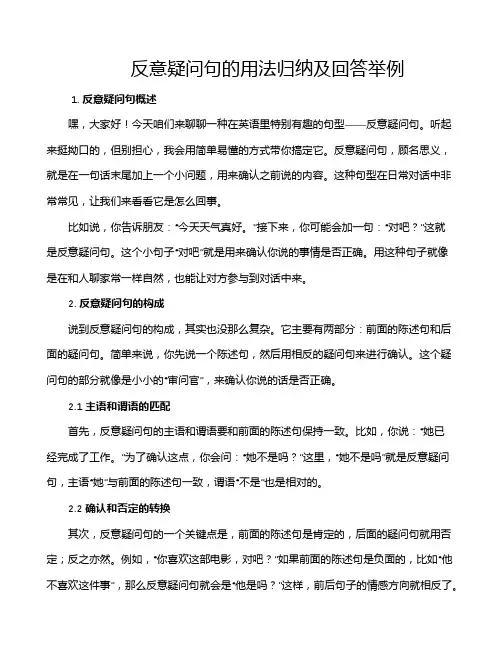
反意疑问句的用法归纳及回答举例1. 反意疑问句概述嘿,大家好!今天咱们来聊聊一种在英语里特别有趣的句型——反意疑问句。
听起来挺拗口的,但别担心,我会用简单易懂的方式带你搞定它。
反意疑问句,顾名思义,就是在一句话末尾加上一个小问题,用来确认之前说的内容。
这种句型在日常对话中非常常见,让我们来看看它是怎么回事。
比如说,你告诉朋友:“今天天气真好。
”接下来,你可能会加一句:“对吧?”这就是反意疑问句。
这个小句子“对吧”就是用来确认你说的事情是否正确。
用这种句子就像是在和人聊家常一样自然,也能让对方参与到对话中来。
2. 反意疑问句的构成说到反意疑问句的构成,其实也没那么复杂。
它主要有两部分:前面的陈述句和后面的疑问句。
简单来说,你先说一个陈述句,然后用相反的疑问句来进行确认。
这个疑问句的部分就像是小小的“审问官”,来确认你说的话是否正确。
2.1 主语和谓语的匹配首先,反意疑问句的主语和谓语要和前面的陈述句保持一致。
比如,你说:“她已经完成了工作。
”为了确认这点,你会问:“她不是吗?”这里,“她不是吗”就是反意疑问句,主语“她”与前面的陈述句一致,谓语“不是”也是相对的。
2.2 确认和否定的转换其次,反意疑问句的一个关键点是,前面的陈述句是肯定的,后面的疑问句就用否定;反之亦然。
例如,“你喜欢这部电影,对吧?”如果前面的陈述句是负面的,比如“他不喜欢这件事”,那么反意疑问句就会是“他是吗?”这样,前后句子的情感方向就相反了。
3. 反意疑问句的回答方式说到反意疑问句的回答,那也是有讲究的哦。
通常,回答的时候要看你是否同意前面的陈述句。
如果同意,就用肯定的回答;如果不同意,就用否定的回答。
举个例子,你的朋友说:“这家餐厅的菜很好吃,对吧?”如果你同意,可以回答:“是的,确实很好吃。
”如果你不同意,可能就会说:“其实我觉得一般般。
”3.1 肯定回答当你同意对方的陈述时,直接用“Yes”或者“确实”来回应。
例如:“这部电影很有趣,不是吗?”你可以说:“是的,我也这么觉得!”这样你就和对方达成了共识。
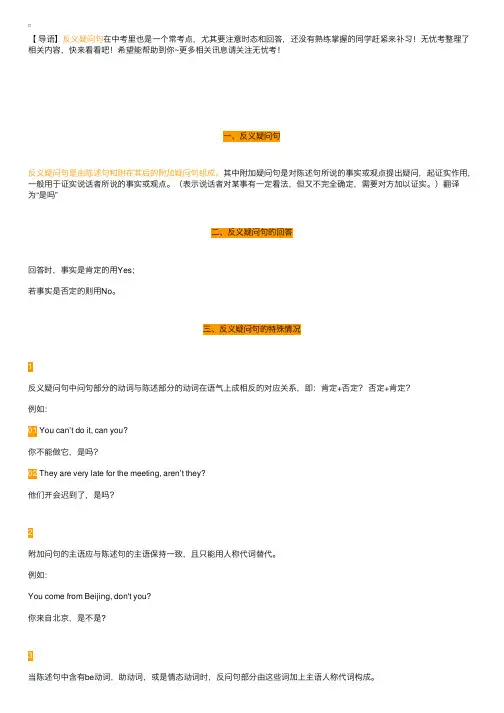
【导语】反义疑问句在中考⾥也是⼀个常考点,尤其要注意时态和回答,还没有熟练掌握的同学赶紧来补习!⽆忧考整理了相关内容,快来看看吧!希望能帮助到你~更多相关讯息请关注⽆忧考!⼀、反义疑问句反义疑问句是由陈述句和附在其后的附加疑问句组成。
其中附加疑问句是对陈述句所说的事实或观点提出疑问,起证实作⽤,⼀般⽤于证实说话者所说的事实或观点。
(表⽰说话者对某事有⼀定看法,但⼜不完全确定,需要对⽅加以证实。
)翻译为“是吗”⼆、反义疑问句的回答回答时,事实是肯定的⽤Yes;若事实是否定的则⽤No。
三、反义疑问句的特殊情况1反义疑问句中问句部分的动词与陈述部分的动词在语⽓上成相反的对应关系,即:肯定+否定?否定+肯定?例如:01 You can’t do it, can you?你不能做它,是吗?02 They are very late for the meeting, aren’t they?他们开会迟到了,是吗?2附加问句的主语应与陈述句的主语保持⼀致,且只能⽤⼈称代词替代。
例如:You come from Beijing, don't you?你来⾃北京,是不是?3当陈述句中含有be动词,助动词,或是情态动词时,反问句部分由这些词加上主语⼈称代词构成。
Be动词包括:am, is, are, was, were助动词有:do, does, did, have(⽤在完成时), has(⽤在完成时)等情态动词有:can, could, may, might, must, will, would, shall, should例如:01 He will go home, won’t he?他要回家了,是吗?02 She doesn’t like to eat popcorn, does she?她不喜欢吃爆⽶花,是吗?4have的不同⽤法,反义疑问句⽤不同的动词。
(1)have表“有”时,反义疑问句谓语动词⽤have/do都⾏。
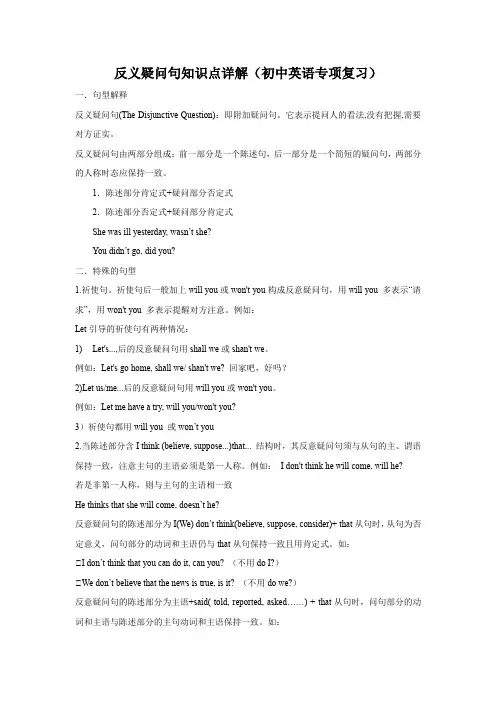
反义疑问句知识点详解(初中英语专项复习)一.句型解释反义疑问句(The Disjunctive Question):即附加疑问句。
它表示提问人的看法,没有把握,需要对方证实。
反义疑问句由两部分组成:前一部分是一个陈述句,后一部分是一个简短的疑问句,两部分的人称时态应保持一致。
1.陈述部分肯定式+疑问部分否定式2.陈述部分否定式+疑问部分肯定式She was ill yesterday, wasn’t she?You didn’t go, did you?二.特殊的句型1.祈使句。
祈使句后一般加上will you或won't you构成反意疑问句,用will you 多表示“请求”,用won't you 多表示提醒对方注意。
例如:Let引导的祈使句有两种情况:1)Let's...,后的反意疑问句用shall we或shan't we。
例如:Let's go home, shall we/ shan't we? 回家吧,好吗?2)Let us/me...后的反意疑问句用will you或won't you。
例如:Let me have a try, will you/won't you?3)祈使句都用will you 或won’t you2.当陈述部分含I think (believe, suppose...)that... 结构时,其反意疑问句须与从句的主、谓语保持一致,注意主句的主语必须是第一人称。
例如:I don't think he will come, will he?若是非第一人称,则与主句的主语相一致He thinks that she will come, doesn’t he?反意疑问句的陈述部分为I(We) don’t think(believe, suppose, consider)+ that从句时,从句为否定意义,问句部分的动词和主语仍与that从句保持一致且用肯定式。
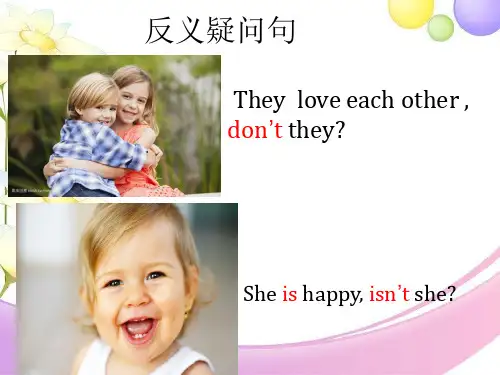
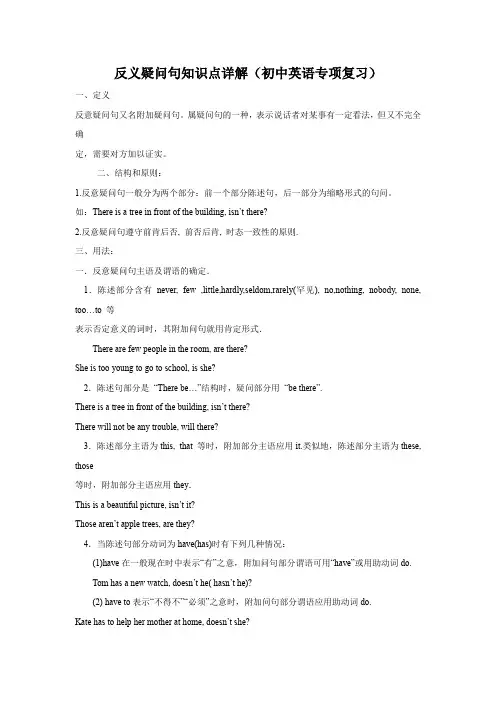
反义疑问句知识点详解(初中英语专项复习)一、定义反意疑问句又名附加疑问句。
属疑问句的一种,表示说话者对某事有一定看法,但又不完全确定,需要对方加以证实。
二、结构和原则:1.反意疑问句一般分为两个部分:前一个部分陈述句,后一部分为缩略形式的句问。
如:There is a tree in front of the building, isn’t there?2.反意疑问句遵守前肯后否, 前否后肯, 时态一致性的原则.三、用法:一.反意疑问句主语及谓语的确定.1.陈述部分含有never, few ,little,hardly,seldom,rarely(罕见), no,nothing, nobody, none, too…to 等表示否定意义的词时,其附加问句就用肯定形式.There are few people in the room, are there?She is too young to go to school, is she?2.陈述句部分是“There be…”结构时,疑问部分用“be there”.There is a tree in front of the building, isn’t there?There will not be any trouble, will there?3.陈述部分主语为this, that 等时,附加部分主语应用it.类似地,陈述部分主语为these, those等时,附加部分主语应用they.This is a beautiful picture, isn’t it?Those aren’t apple trees, are they?4.当陈述句部分动词为have(has)时有下列几种情况:(1)have在一般现在时中表示“有”之意,附加问句部分谓语可用“have”或用助动词do.Tom has a new watch, doesn’t he( hasn’t he)?(2) have to表示“不得不”“必须”之意时,附加问句部分谓语应用助动词do.Kate has to help her mother at home, doesn’t she?(3) have 表示“吃、喝、玩、度过”等意时,其附加问句的谓语应用助动词do.They have a good time in Beijing, don’t they?(4)have 在完成时中,其附加问句谓语动词应用have.Lucy has ever been to Japan, hasn’t she?(5) had better 最好,在祈使句中,其附加问句谓语动词应用hadYou had better clean the room,hadn’t you?5.肯定的祈使句的附加问句可用will you或won’t you,否定的祈使句的附加问句用will you.Listen to me carefully, will you?Don’t play with fire, will you?6.以let’s开头的祈使句,附加问句用shall we;而以let us 开头的祈使句,附加问句用will you.Let’s go to the park, shall we?Let us help you, will you?7.think, believe, expect, imagine, suppose等引导的宾语从句:A.主语是第一人称(应特别注意否定的转移)I don’t think he is bright, is he?We believe she can do it better, can’t she?B. 如果主语不是第一人称则疑问部分与主句相对应构成反意疑问句He thought they were wrong, didn’t he?8.否定前缀或后缀(否定前缀dis-, un-, im-或否定后缀-less,如dislike, discourage, unfair, unable等)不能视为否定词,其反意疑问句仍用否定形式。
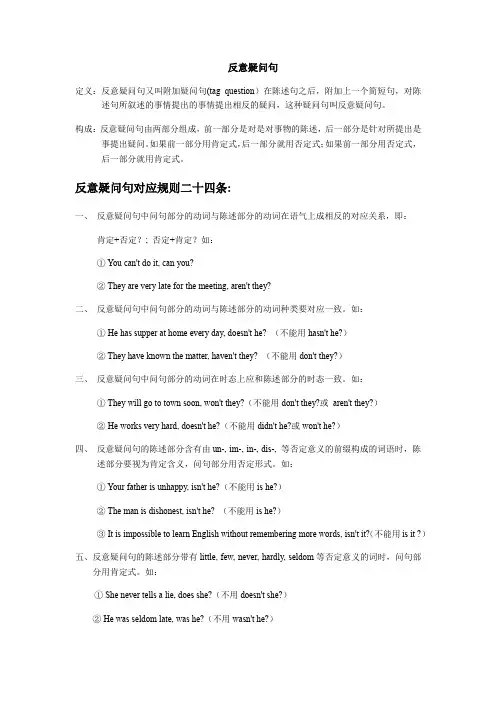
反意疑问句定义:反意疑问句又叫附加疑问句(tag question)在陈述句之后,附加上一个简短句,对陈述句所叙述的事情提出的事情提出相反的疑问,这种疑问句叫反意疑问句。
构成:反意疑问句由两部分组成,前一部分是对是对事物的陈述,后一部分是针对所提出是事提出疑问。
如果前一部分用肯定式,后一部分就用否定式;如果前一部分用否定式,后一部分就用肯定式。
反意疑问句对应规则二十四条:一、反意疑问句中问句部分的动词与陈述部分的动词在语气上成相反的对应关系,即:肯定+否定?; 否定+肯定?如:① You can't do it, can you?② They are very late for the meeting, aren't they?二、反意疑问句中问句部分的动词与陈述部分的动词种类要对应一致。
如:① He has supper at home every day, doesn't he? (不能用hasn't he?)② They have known the matter, haven't they? (不能用don't they?)三、反意疑问句中问句部分的动词在时态上应和陈述部分的时态一致。
如:① They will go to town soon, won't they?(不能用don't they?或aren't they?)② He works very hard, doesn't he?(不能用didn't he?或won't he?)四、反意疑问句的陈述部分含有由un-, im-, in-, dis-, 等否定意义的前缀构成的词语时,陈述部分要视为肯定含义,问句部分用否定形式。
如:① Your father is unhappy, isn't he?(不能用is he?)② The man is dishonest, isn't he? (不能用is he?)③ It is impossible to learn English without remembering more words, isn't it?(不能用is it ?)五、反意疑问句的陈述部分带有little, few, never, hardly, seldom等否定意义的词时,问句部分用肯定式。

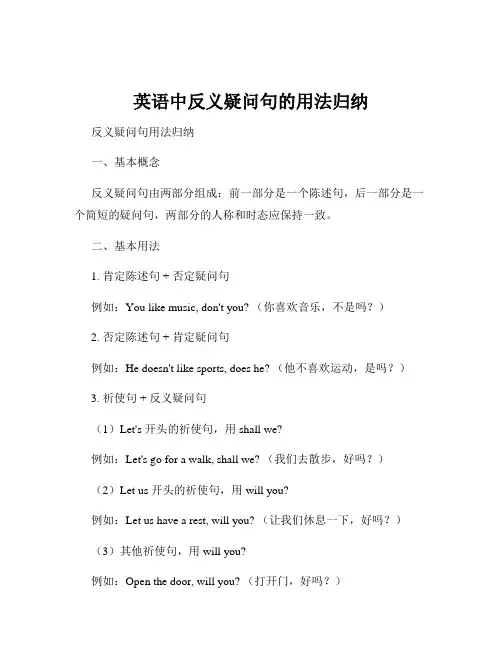
英语中反义疑问句的用法归纳反义疑问句用法归纳一、基本概念反义疑问句由两部分组成:前一部分是一个陈述句,后一部分是一个简短的疑问句,两部分的人称和时态应保持一致。
二、基本用法1. 肯定陈述句 + 否定疑问句例如:You like music, don't you? (你喜欢音乐,不是吗?)2. 否定陈述句 + 肯定疑问句例如:He doesn't like sports, does he? (他不喜欢运动,是吗?)3. 祈使句 + 反义疑问句(1)Let's 开头的祈使句,用 shall we?例如:Let's go for a walk, shall we? (我们去散步,好吗?)(2)Let us 开头的祈使句,用 will you?例如:Let us have a rest, will you? (让我们休息一下,好吗?)(3)其他祈使句,用 will you?例如:Open the door, will you? (打开门,好吗?)4. 含有 must 的反义疑问句(1)must 表示“必须”时,用 needn't例如:You must finish your homework today, needn't you? (你今天必须完成作业,不是吗?)(2)must 表示推测“一定,肯定”时,根据实际情况而定例如:He must be very tired, isn't he? (他一定很累了,不是吗?)5. 含有否定词的反义疑问句当陈述句中有 never, few, little, nothing, nobody 等否定词时,反义疑问句用肯定形式。
例如:There is nothing in the box, is there? (盒子里什么都没有,是吗?)三、固定搭配1. “I am + 表语”,反义疑问句用“aren't I”例如:I'm late, aren't I? (我迟到了,不是吗?)2. 陈述部分是“there be”结构,反义疑问句用“be there”例如:There is a book on the desk, isn't there? (桌子上有一本书,不是吗?)3. 当陈述部分主语是不定代词 everyone, somebody, nobody, everyone 等时,反义疑问句用 they 或 he例如:Everyone is here, aren't they? (大家都在这儿,不是吗?)4. 当陈述部分主语是 this, that 时,反义疑问句用 it;当陈述部分主语是 these, those 时,反义疑问句用 they例如:This is a pen, isn't it? (这是一支钢笔,不是吗?)5. 当陈述部分是主从复合句时,反义疑问句与主句的主语和谓语保持一致例如:He said he would come, didn't he? (他说他会来,不是吗?)双语例句:1. I have a lot of friends, don't I? (我有很多朋友,不是吗?)2. She doesn't speak French, does she? (她不会说法语,是吗?)3. Have a cup of coffee, will you? (喝杯咖啡,好吗?)4. We should study hard, shouldn't we? (我们应该努力学习,不是吗?)5. They have been to Beijing, haven't they? (他们去过北京,不是吗?)6. You aren't a doctor, are you? (你不是医生,对吧?)7. There are some apples on the tree, aren't there? (树上有一些苹果,不是吗?)8. Nobody knows the answer, do they? (没人知道答案,对吧?)9. This isn't your book, is it? (这不是你的书,对吧?)10. Those are beautiful flowers, aren't they? (那些是漂亮的花,不是吗?)11. He can swim very well, can't he? (他游泳游得很好,不是吗?)12. She never tells lies, does she? (她从不说谎,对吧?)13. We had a great time yesterday, didn't we? (我们昨天玩得很开心,不是吗?)14. If it rains tomorrow, we won't go hiking, will we? (如果明天下雨,我们就不去徒步了,对吧?)15. You think he is right, don't you? (你认为他是对的,不是吗?)16. Mary has few friends here, does she? (玛丽在这儿几乎没朋友,对吧?)17. The boy doesn't like vegetables, does he? (这男孩不喜欢蔬菜,是吗?)18. Everyone wants to be happy, don't they? (每个人都想快乐,不是吗?)19. I'm a good student, aren't I? (我是个好学生,不是吗?)20. He told you the truth, didn't he? (他告诉你真相了,不是吗?)。
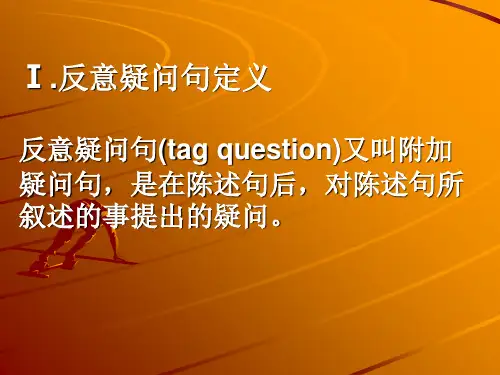
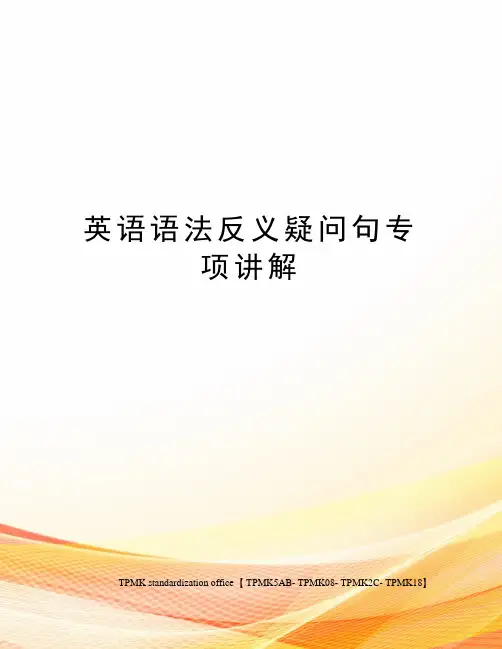
英语语法反义疑问句专项讲解TPMK standardization office【 TPMK5AB- TPMK08- TPMK2C- TPMK18】反义疑问句一、反义疑问句又叫附加疑问句。
反义疑问句由两部分组成:前一部分是一个陈述句,后一部分是一个简短的疑问句,两部分的人称时态应保持一致。
1.陈述部分为肯定式 + 疑问部分为否定式(如果陈述部分的否定词带有否定前缀,那么,该陈述部分作肯定处理,附加疑问部分一般仍用否定形式)e.g. She was ill yesterday, wasn’t sheTom dislikes the book, doesn’t he2.陈述部分为否定式 + 疑问部分为肯定式(陈述部分用 no, nothing, nobody, never, few, seldom, hardly, rarely, little等否定或半否定含义的词时,疑问部分用肯定式。
)e.g. He can’t ride a bike, can heSome plants never blown (开花), do they二、附加疑问句(一)主语的选择1.陈述部分的主语是I,疑问部分要用 aren't I.I’m as tall as your sister, aren't I?注:当陈述部分的主语是I,而句子又用来征询对方的意见时,附加疑问句中的主语用you。
如:I find English very interesting, don’t youI don’t like that film, do you2.当陈述部分的主语是everybody, everyone, someone, nobody, no one, somebody等合成代词时,附加疑问句中的主语通常用they,亦可用he,如:Somebody phoned while I was out, didn’t theyEveryone enjoyed the party, didn’t theyNobody wants to go there, does he3.当陈述部分的主语是不定代词everything, nothing, anything, something 时,附加疑问句中的主语一般用it,如:Everything seems all right now, doesn’t itNothing is kept in good order, is itSomething must be done to stop pollution, isn’t it4.当陈述部分的主语是指示代词this, that或these, those时,附加疑问句中的主语分别用it和they,如:This is important, isn’t itThat isn’t correct, is itThese are your friends Tom and Jack, aren’t they5.如果陈述部分是以代词one作主语,附加疑问句中的主语在正式场合用one,非正式场合下可以用you或he,如:One can’t be too careful, can one或can youOne should do his duty, shouldn’t he6.当陈述句为there be结构时,附加疑问句中的主语也用there。
(完整版)英语语法:反义疑问句专项讲解反义疑问句一、反义疑问句又叫附加疑问句。
反义疑问句由两部分组成:前一部分是一个陈述句,后一部分是一个简短的疑问句,两部分的人称时态应保持一致。
1.陈述部分为肯定式+ 疑问部分为否定式(如果陈述部分的否定词带有否定前缀,那么,该陈述部分作肯定处理,附加疑问部分一般仍用否定形式)e.g. She was ill yesterday, wasn’t she?Tom dislikes the book, doesn’t he?2.陈述部分为否定式+ 疑问部分为肯定式(陈述部分用no, nothing, nobody, never, few, seldom, hardly, rarely, little等否定或半否定含义的词时,疑问部分用肯定式。
)e.g. He can’t ride a bike, can he?Some plants never blown (开花), do they ?二、附加疑问句(一)主语的选择1.陈述部分的主语是I,疑问部分要用aren't I.I’m as tall as your sister, aren't I?注:当陈述部分的主语是I,而句子又用来征询对方的意见时,附加疑问句中的主语用you。
如:I find English very interesting, don’t you?I don’t like that film, do you?2.当陈述部分的主语是everybody, everyone, someone, nobody, no one, somebody等合成代词时,附加疑问句中的主语通常用they,亦可用he,如:Somebody phoned while I was out, didn’t they?Everyone enjoyed the party, didn’t they?Nobody wants to go there, does he?3.当陈述部分的主语是不定代词everything, nothing, anything, something时,附加疑问句中的主语一般用it,如:Everything seems a ll right now, doesn’t it?Nothing is kept in good order, is it?Something must be done to stop pollution, isn’t it?4.当陈述部分的主语是指示代词this, that或these, those时,附加疑问句中的主语分别用it 和they,如:This is important, isn’t it?That isn’t correct, is it?These are your frien ds Tom and Jack, aren’t they?5.如果陈述部分是以代词one作主语,附加疑问句中的主语在正式场合用one,非正式场合下可以用you或he,如:One can’t be too careful, can one?或can you?One should do his duty, shouldn’t he?6.当陈述句为there be结构时,附加疑问句中的主语也用there。
反义疑问句一、反义疑问句又叫附加疑问句。
反义疑问句由两部分组成:前一部分是一个陈述句,后一部分是一个简短的疑问句,两部分的人称时态应保持一致。
1.陈述部分为肯定式+ 疑问部分为否定式(如果陈述部分的否定词带有否定前缀,那么,该陈述部分作肯定处理,附加疑问部分一般仍用否定形式)e.g. She was ill yesterday, wasn’t she?Tom dislikes the book, doesn’t he?2.陈述部分为否定式+ 疑问部分为肯定式(陈述部分用no, nothing, nobody, never, few, seldom, hardly, rarely, little等否定或半否定含义的词时,疑问部分用肯定式。
)e.g. He can’t ride a bike, can he?Some plants never blown (开花), do they ?二、附加疑问句(一)主语的选择1.陈述部分的主语是I,疑问部分要用aren't I.I’m as tall as your sister, aren't I?注:当陈述部分的主语是I,而句子又用来征询对方的意见时,附加疑问句中的主语用you。
如:I find English very interesting, don’t you?I don’t like that film, do you?2.当陈述部分的主语是everybody, everyone, someone, nobody, no one, somebody等合成代词时,附加疑问句中的主语通常用they,亦可用he,如:Somebody phoned while I was out, didn’t they?Everyone enjoyed the party, didn’t they?Nobody wants to go there, does he?3.当陈述部分的主语是不定代词everything, nothing, anything, something时,附加疑问句中的主语一般用it,如:Everything seems all right now, doesn’t it?Nothing is kept in good order, is it?Something must be done to stop pollution, isn’t it?4.当陈述部分的主语是指示代词this, that或these, those时,附加疑问句中的主语分别用it 和they,如:This is important, isn’t it?That isn’t correct, is it?These are your friends Tom and Jack, aren’t they?5.如果陈述部分是以代词one作主语,附加疑问句中的主语在正式场合用one,非正式场合下可以用you或he,如:One can’t be too careful, can one?或can you?One should do his duty, shouldn’t he?6.当陈述句为there be结构时,附加疑问句中的主语也用there。
四、反意疑问句1、结构陈述句+简短问句Eg: He is a student, isn’t he?前肯后否2、原则①:前肯后否;前否后肯。
否定词有:few, little, hardly, never, no, not,Seldom, neither, nothing, none,nobody, no one,scarcely等,如果前面有这些词,后面就不加not.②:前面用be动词、助动词、情态动词,后面也一样.前面如果没有be动词、助动词、情态动词,就去借助动词do, does, did,借哪一个由前面的谓语动词决定。
③: 前后在人称、时态上要一致。
简短问句必须用缩写形式④: 前面主语是this/that; these/those,问句主语用it/they代替⑤:前面主语是人名,问句中用相应的she/he/they代替⑥: 前面主语是表示“物”的不定代词,问句中主语用it代替. ⑦:含有think, believe, suppose, imagine, expect等动词后接宾语从句构成的主从复合句在构成反意疑问句时,视情况不同有两种不同的构成方式。
A: 当主句的主语为第一人称时,其后的简短问句应与从句相一致。
Eg: I don't think he is bright, is he?主句从句与从句一致B:当主句的主语为第二、三人称时,其后的简短问句则应与主句相一致(此时,否定只看主句,与从句无关...)Eg:They don't believe she's an engineer, do they?主句与主句一致Everything goes well, doesn’t it ?LiMing can speak English, can’t he ?This isn’t your pen, is it ?3、固定的形式1).Let’s…………,shall we ?2). Let us…………,will you?3). 祈使句…………, will you ?附练习:变反义疑问句1. You are not going home.2. You have got a green pencil.3. She can swim.4. He came here by bike.5. This is his book.6. John has learnt about China.7. Lucy can draw beautiful pictures.8. It isn’t a nice watch.9.There is a little milk in the glass.10. Jenny and Bill play basketball together after school.11. His sister does eye exercises every day.12. It’s a fine day today.13. He will go to Chengdu tomorrow.14. Her father had lunch at home.15. There is little water in the bottle .16. Let’s have a long talk.17. Jenny has never been late for school.18. Lily never went to the zoo by bus last year.19. Jim had few friends there.20.Kate has little bread for breakfast.21. Open the door 22. You’ve never seen dinosaur eggs23. His sister had a bad cough24. Mr. Green went to Shenzhen on business last week25. Danny can hardly understand any Chinese26. Don’t smoke in the meeting-room27. Miss Cheng will never forget her first visit to Canada28. The lady couldn’t say a word when she saw the snake29. he'll go shopping30.You'd like to go with me31. There are few apples in the basket.32.He can hardly swim.33.They seldom come late.34. I don't believe that he can translate this book.35. Your sister supposes she needs no help.36. She doesn't expect that we are coming so soon.37.Don't make much noise.。
反义疑问句知识点总结反义疑问句是英语中一种特殊的句型结构,由一个陈述句和一个简短的疑问句构成,用来表示说话者的疑惑、请求确认或强调说话者的观点。
本文将对反义疑问句的用法、结构、注意事项以及相关练习进行总结和概括。
一、反义疑问句的用法反义疑问句常用于口语交流中,用来询问对方的意见、请求确认信息或者表示说话者对某种情况的强调。
它可以通过改变陈述句的词序,使用“肯定→否定”或“否定→肯定”的方式来构成。
二、反义疑问句的结构1. 如果陈述句是肯定形式,疑问句部分为否定形式。
例如:- You are a student, aren't you?- They have finished their homework, haven't they?2. 如果陈述句是否定形式,疑问句部分为肯定形式。
例如:- He doesn't like coffee, does he?- We haven't seen the movie, have we?3. 如果陈述句中包含情态动词,反义疑问句中的疑问部分要使用原来的情态动词。
例如:- She will come to the party, won't she?- They can swim, can't they?4. 如果陈述句中使用了“let's”来表示建议,反义疑问句中疑问部分要使用“shall we”。
例如:- Let's go for a walk, shall we?5. 如果陈述句中使用了“there is”或“there are”,反义疑问句中疑问部分要使用“isn't there”或“aren't there”。
例如:- There is a book on the table, isn't there?三、注意事项1. 反义疑问句的结构要与陈述句的主语保持一致。
- She is a doctor, isn't she?(正确)- She is a doctor, aren't you?(错误)2. 主语如果是第三人称单数,疑问句的代词要使用对应的第三人称代词,即“he、she、it”。
反义疑问句一、反义疑问句又叫附加疑问句。
反义疑问句由两部分组成:前一部分是一个陈述句,后一部分是一个简短的疑问句,两部分的人称时态应保持一致。
1.陈述部分为肯定式+疑问部分为否定式(如果陈述部分的否定词带有否定前缀,那么,该陈述部分作肯定处理,附加疑问部分一般仍用否定形式)e.g.She was ill yesterday, wasn’t she?Tom dislikesthebook,doesn’t he?2.陈述部分为否定式+疑问部分为肯定式(陈述部分用no,nothing,nobody,never, few, seldom, hardly, rarely, little 等否定或半否定含义的词时,疑问部分用肯定式。
)e.g.Hecan’t ride abike, can he?Someplantsnever blown (开花),dothey?二、附加疑问句(一)主语的选择1.陈述部分的主语是I,疑问部分要用aren't I.I’mas tall as your sister, aren't I?注:当陈述部分的主语是I,而句子又用来征询对方的意见时,附加疑问句中的主语用you。
如:I find English very interesting, don’tyou?I don’t like that film,doyou?2.当陈述部分的主语是everybody, everyone, someone,nobody, no one, someb ody等合成代词时,附加疑问句中的主语通常用they,亦可用he,如:Somebody phonedwhileIwas out,didn’t they?Everyone enjoyed theparty,didn’t they?Nobody wants togo there, does he?3.当陈述部分的主语是不定代词everything,nothing,anything, something时,附加疑问句中的主语一般用it,如:Everything seems all rightnow, doesn’t it?Nothing is kept ingood order, is it?Something mustbedoneto stoppollution, isn’t it?4.当陈述部分的主语是指示代词this, that或these, those时,附加疑问句中的主语分别用it和they,如:This isimportant, isn’t it?That isn’t correct,is it?These are your friendsTom and Jack, aren’tthey?5.如果陈述部分是以代词one作主语,附加疑问句中的主语在正式场合用one,非正式场合下可以用you或he,如:One can’tbe too careful,can one?或can you?One should do his duty, shouldn’t he?6.当陈述句为therebe结构时,附加疑问句中的主语也用there。
如:There’s no help for it,isthere?There’ssomething wrong, isn’tthere?7.当陈述部分为主从复合句时,附加疑问部分一般应与主句的主语和谓语动词保持对应关系。
如:She saysthatI didit,doesn’t she?Itoldthem not everybody could do it,didn’t I?但当陈述部分的主语是I,谓语是think,believe,suppose, expect这类动词时,附加疑问部分则往往与从句中的主语和谓语动词保持对应关系,但要注意否定的转移。
Isuppose that he’s seriousisn’t he?Idon’tthinkshecares,does she?8.当陈述部分是并列句,附加疑问句则需和就近的分句的主语和谓语一致。
如: XiaoLin hasbeen writing lettersall afternoon but he should finish them now, shouldn’t he?9.在由“祈使句+附加疑问”构成的附加疑问句中,附加疑问部分的主语一般用you。
如:Don’t open the door, willyou?Give me some cigarettes,canyou?Take a rest, why don’t you?但以let’s开头的祈使句,附加疑问部分用shall we;以letus开头的祈使句,如果含义是allowus,不包括听话人在内,疑问部分用will you。
如:Let’s have a basketballmatch this afternoon,shall we?Let us goout for a rest, will you?10.陈述句子中的主语为动词不定式短语、动名词短语或其他短语时,疑问部分的主语通常用it。
如:Learning howtorepair motorstakes a long time,doesn’t it?Betweensix and seven will suit you,won’t it?Wheretoholdthe meeting hasnot beendecided,has it?(二)谓语动词的选择1.当陈述部分带有情态动词must表示“必须”时,疑问部分用mustn’t。
如:Youmust work hard next term, mustn’tyou?Imust answer theletter,mustn’t I?但若表推测这层含义时,不能用must,而要根据陈述部分的不定式结构(即must之后的动词)以及含义采用相应的动词形式。
如:You musthavemade a mistake, haven’t you?They musthaveseenthe film lastweek, didn’t they?He must be in the library,isn’the?2.当陈述部分含有used to时,疑问部分可用usedn’t或didn’t。
如: The old manused tosmoke, didn’t/usedn’t he?Tom used to live here,usedn’t /didn’t he?3.当陈述部分带有情态动词oughtto时,疑问部分用oughtn’t或shouldn’t。
如: Heought to know theanswer, oughtn’the?We ought to read this book,oughtn’t/ shouldn’twe?4.当陈述部分含有情态动词dare或need时,疑问部分常用need/dare +主语。
We need notdoit again,needwe ?He dare not say so, dareyou?但当dare, need 为实义动词时,疑问部分用助动词do+主语。
She doesn't dare to go homealone,doesshe?5.当陈述部分含有had better时,疑问部分用hadn’t。
如:You’d better finish your homework now, hadn’t you?6.感叹句后的附加疑问句的谓语动词需用be的现在时,且常用否定形式。
如:What a cleverboy, isn’t he?What a lovelyday,isn’t it?7.陈述句中的谓语动词是wish,表示愿望时,附加疑问句用may,且用肯定形式。
如:I wish to have a chanceto learn English, may I?8.当陈述部分带有表示“所有”含义的动词have(has)时,疑问部分既可用have形式,也可用do形式。
如:You have anew bike, haven’t you(或don’t you)?Shedoesn’thave anymoneyin her pocket, does she?9.陈述部分有have to +v. (had to + v.),疑问部分常用don't+主语(didn't+主语)。
如:We have to get there ateight tomorrow, don't we?10.陈述部分有would rather +v.,疑问部分多用wouldn't +主语。
如:He wouldrather read it ten times thanrecite it, wouldn'the?11.陈述部分有You'd liketo+v. 疑问部分用wouldn't +主语。
如:You'dlike to go with me,wouldn'tyou?12.陈述部分由neither… nor, either… or 连接的并列主语时,疑问部分根据其实际逻辑意义而定。
Neitheryou norI amengineer,are we?13.在口语和非正式文体中,为了加强语气,只是表示某种惊奇、怀疑、反感、讽刺等感情而并不是为了寻求回答,这时前后两部分的肯定、否定是一致的。
如:Oh, he is a writer, is he?You’ll not go,won’tyou?(三)反义疑问句的回答对反意疑问句的回答,无论问题的提法如何,如果事实是肯定的,就用yes,事实是否定的,就要用no。
例:—He likes playing football,doesn’t he? 他喜欢踢足球,是吗?—Yes,he does. / No, hedoesn’t.是的,他喜欢。
/ 不是,他不喜欢。
当陈述句部分是否定结构,附加疑问句部分用肯定式提问时,回答yes或no与汉语的意思正好相反。
这种回答的yes要译成“不”,no要译成“是”。
—Hissister didn’t attend the meeting, did she?他妹妹没有参加会议,是吗?—Yes, she did. / No,shedidn’t. 不,她参加了。
/ 是的,她没参加。
反义疑问句练习1.Lindaate nothingthis morning, ___?A. didn’t she B. was sheC.didsheD. wasn’t she2.There’s hardly___ milk in the bottle, _____there?A.no, isn’t B.some, is C. little, isn’t D.any,is3. Hehas never ridden a horse before,___?A.does he B.hashe C. hasn’t heD.doesn’the4. — He seldom camehere, _____? —Yessir.A.didn’t he B. does he C. doesn’t heD. di dhe5.Everything seems all right, _____ ?A.doesit B. don’t they C.won’titD. doesn’t it7.One can’tbe too modest, can _____ ?A. one B. he C.it D.we8. No one failedin the exam,_____ ?A. washe B. did oneC.didthey D.didn’t he10. Neither you nor I am a artist,_____?A.am IB. aren’t we C.are weD. ain’t I11. He can’tbe her father, _____ he?A.is B. isn’tC.can D. can’t12. They have no timetovisit the museum, _____?A.do they B. haven’t they C. don’t theyD.will they14. You’d better goat once, _____you?A. hadn’tB. did C. didn’t D. don’t15. You’d rather work thanplay, _____ you?A. hadn’tB. wouldn’tC.didn’t D.mustn’t16. Youdare not do that, _____you?A.don’tB. doC. dareD. daren’t18. He dislikes thetwo subjects, _____ he?A. does B. doesn’tC. is D. isn’t19. These tools are useless now, _____ ?A. arethey B. aren’t they C.is itD. isn’tit20. He used to get up at 6:30,_____ he?A.didn’t heB. didhe C.usedhe D.wouldn’t he22. Heought towinthefirst prize,_______he?A. mustn’tB. oughtn’tC. shouldn’tD. Both B and C.23.Let’s go there by bus,___?A. will youB. shallweC. don’t you D.will you24.Letus go to play football,___?A.will youB. shallwe C. do we D. are we25. Don’tforget to give Polly some food and change her water, ___?A. will you B. shall weC. won’t you D. do you26.—Let’s go shopping this afternoon, _____?—All right. A. will we B.shall we C. don’twe D. are we27. — Passmethe dictionary, _____?—Yes, withpleasure.A.would you B.will you C.won’t you D.wouldn’t you30. There is littlewater in theglass,____?A.isn’tthere B. isn’t itC.isit D. is there32.Therewon’tbe anyconcertthisSaturdayevening,_____ ?A. will there notB.will there C.is there D. won’t33.— I guessshetaughtherself Japanese, ______?—Yes. A.don’t IB.did she C. doI D. didn’tshe34. Idon’t believe youareright, _____?A. are you B.do you C. won’t you D. do35. Shedoesn’tthink that Tomsingsbest inthe class,_____ ? A.does she B.doesn’t she C. does heD. doesn’t he37. I know youdidn’t want to hurt me,_____?A. didyouB.didn’t you C. doI D. don’t I38.If my father were here,hewouldbe veryhappy, _____ ?A. weren’t heB. werehe C. wouldn’t he D.wouldhe--。